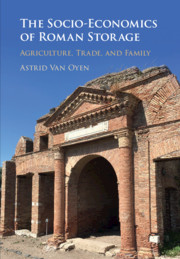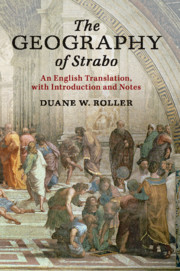Refine search
Actions for selected content:
23990 results in Ancient history
Figures
-
- Book:
- The Socio-Economics of Roman Storage
- Published online:
- 06 May 2020
- Print publication:
- 14 May 2020, pp xi-xii
-
- Chapter
- Export citation
Contents
-
- Book:
- The Socio-Economics of Roman Storage
- Published online:
- 06 May 2020
- Print publication:
- 14 May 2020, pp vii-viii
-
- Chapter
- Export citation
Index
-
- Book:
- The Socio-Economics of Roman Storage
- Published online:
- 06 May 2020
- Print publication:
- 14 May 2020, pp 281-284
-
- Chapter
- Export citation
Appendices
-
- Book:
- The Socio-Economics of Roman Storage
- Published online:
- 06 May 2020
- Print publication:
- 14 May 2020, pp 185-196
-
- Chapter
- Export citation
Preface
-
- Book:
- The Socio-Economics of Roman Storage
- Published online:
- 06 May 2020
- Print publication:
- 14 May 2020, pp xv-xviii
-
- Chapter
- Export citation

The Socio-Economics of Roman Storage
- Agriculture, Trade, and Family
-
- Published online:
- 06 May 2020
- Print publication:
- 14 May 2020

The Geography of Strabo
- An English Translation, with Introduction and Notes
-
- Published online:
- 24 April 2020
- Print publication:
- 29 May 2014
Chapter 5 - The Confluence of Ethnographic Discourse and Political Legitimacy
-
- Book:
- Rome, China, and the Barbarians
- Published online:
- 16 April 2020
- Print publication:
- 23 April 2020, pp 257-310
-
- Chapter
- Export citation
Chapter 1 - Ethnography in the Classical Age
-
- Book:
- Rome, China, and the Barbarians
- Published online:
- 16 April 2020
- Print publication:
- 23 April 2020, pp 28-95
-
- Chapter
- Export citation
Chapter 4 - New Emperors and Ethnographic Clothes
-
- Book:
- Rome, China, and the Barbarians
- Published online:
- 16 April 2020
- Print publication:
- 23 April 2020, pp 209-256
-
- Chapter
- Export citation
Index
-
- Book:
- Rome, China, and the Barbarians
- Published online:
- 16 April 2020
- Print publication:
- 23 April 2020, pp 359-370
-
- Chapter
- Export citation
Acknowledgments
-
- Book:
- Rome, China, and the Barbarians
- Published online:
- 16 April 2020
- Print publication:
- 23 April 2020, pp xix-xix
-
- Chapter
- Export citation
Maps
-
- Book:
- Rome, China, and the Barbarians
- Published online:
- 16 April 2020
- Print publication:
- 23 April 2020, pp ix-ix
-
- Chapter
- Export citation
Dedication
-
- Book:
- Rome, China, and the Barbarians
- Published online:
- 16 April 2020
- Print publication:
- 23 April 2020, pp v-vi
-
- Chapter
- Export citation
Chapter 3 - Ethnography in a Post-Classical Age
-
- Book:
- Rome, China, and the Barbarians
- Published online:
- 16 April 2020
- Print publication:
- 23 April 2020, pp 130-208
-
- Chapter
- Export citation
Contents
-
- Book:
- Rome, China, and the Barbarians
- Published online:
- 16 April 2020
- Print publication:
- 23 April 2020, pp vii-viii
-
- Chapter
- Export citation
Chapter 2 - The Barbarian and Barbarian Antitheses
-
- Book:
- Rome, China, and the Barbarians
- Published online:
- 16 April 2020
- Print publication:
- 23 April 2020, pp 96-129
-
- Chapter
- Export citation
A Note to the Reader
-
- Book:
- Rome, China, and the Barbarians
- Published online:
- 16 April 2020
- Print publication:
- 23 April 2020, pp xx-xx
-
- Chapter
- Export citation
Conclusion
-
- Book:
- Rome, China, and the Barbarians
- Published online:
- 16 April 2020
- Print publication:
- 23 April 2020, pp 311-333
-
- Chapter
- Export citation
Bibliography
-
- Book:
- Rome, China, and the Barbarians
- Published online:
- 16 April 2020
- Print publication:
- 23 April 2020, pp 334-358
-
- Chapter
- Export citation
